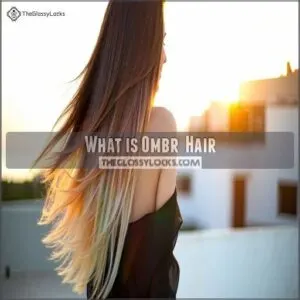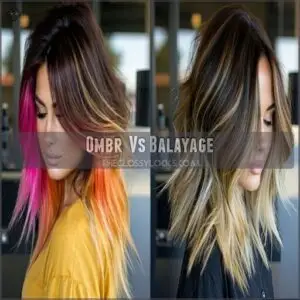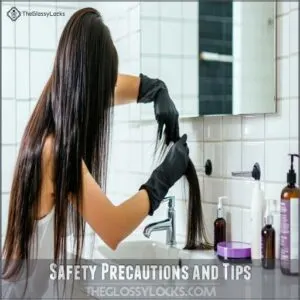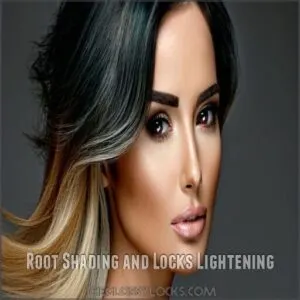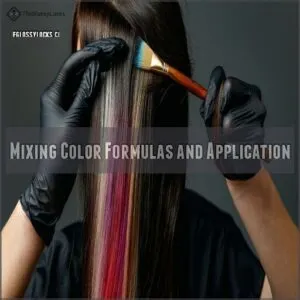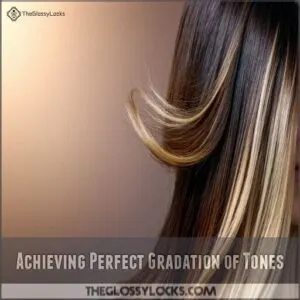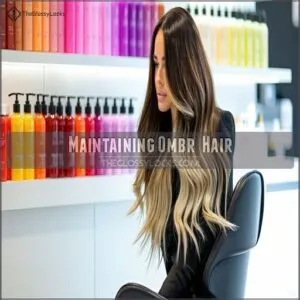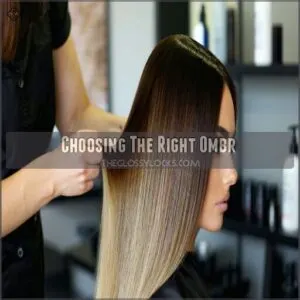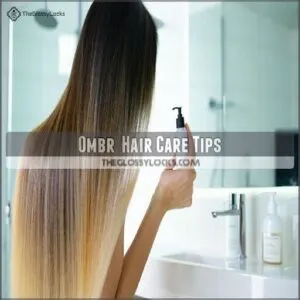This site is supported by our readers. We may earn a commission, at no cost to you, if you purchase through links.
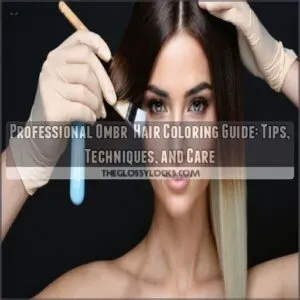 A professional ombré hair coloring guide helps you achieve that perfect fade from dark roots to lighter ends, creating a chic, sun-kissed effect.
A professional ombré hair coloring guide helps you achieve that perfect fade from dark roots to lighter ends, creating a chic, sun-kissed effect.
Start by sectioning dry hair and using a high-quality bleach or color to lighten the tips. Blend upward with a brush or comb to avoid harsh lines.
Timing is everything—process just long enough to lift but not damage. After rinsing, tone the lightened areas to neutralize brassiness.
Finish with hydrating treatments to protect your strands. The key is control, patience, and the right tools.
Want flawless gradation and color ideas? There’s more wisdom where this came from!
Table Of Contents
Key Takeaways
- Blend the color from dark roots to light ends using a high-quality bleach or dye, ensuring a smooth gradient by backcombing or applying with a brush.
- Protect your hair with heat protectants, color-safe shampoo, and moisturizing masks to maintain vibrancy and reduce damage.
- Regular toning and root touch-ups keep your ombré fresh and brass-free while minimizing regrowth visibility.
- Consult a professional stylist for tailored advice, seamless blending, and to avoid unnecessary damage or uneven results.
What is Ombré Hair
Ombré is a hair coloring technique where the color gradually shifts from darker at the roots to lighter at the ends, creating a natural, shaded effect.
A stunning blend of tones, ombré transitions from dark to light, giving your hair a bold, natural, and effortlessly stylish look.
It’s popular for its bold look, versatility, and ability to complement all hair types and lengths.
Ombré Definition and Technique
The ombré hair technique creates a seamless color gradient, blending darker roots into lighter ends for a sun-kissed effect.
It uses precise root smudging and careful hair sectioning to facilitate smooth transitions.
Foil placement and dye saturation are key for consistent results.
This professional ombre hair coloring method works on all hair types, offering a bold, natural look that’s effortlessly stylish.
Ombré Variations and Colors
Ombre hair colors offer a range of creative options.
From subtle to bold, you’ll find something inspiring:
- Blonde ombré: Ash, platinum, or vibrant shades add brightness.
- Purple ombré: Lilac or violet for bold statements.
- Pink ombré: Blush tones to pastel ombre.
- Blue ombré: Dreamy, cool looks.
- Caramel ombré: Sweet warmth suits brown tones perfectly.
Reverse Ombré Explanation
If you’re intrigued by the bold contrast of ombré but want a twist, reverse ombré flips the script.
With this dark-to-light inversion, lighter roots blend into darker ends, offering unique root color options.
Perfect for medium-length or layered haircuts, the reverse ombré highlights maintenance differences while opening creative avenues for color combination ideas.
This ombre hair technique guarantees standout results.
Ombré, however, often requires lightening, which can lead to potential hair damage.
Ombré Vs Balayage
If you’re deciding between ombré and balayage, it’s all about the look and technique.
Ombré offers a bold gradient from dark to light, while balayage creates natural, sun-kissed highlights with a hand-painted touch.
Key Differences Between Techniques
Visualizing the ombre hair technique? Explore these key contrasts with balayage:
| Criteria | Ombré | Balayage |
|---|---|---|
| Application | Structured gradient structure | Freehand, sweeping |
| Color Boldness | Dramatic contrast | Subtle, sun-kissed |
| Maintenance | Higher upkeep for contrast | Lower due to natural fades |
Professional ombre hair coloring requires precision, whereas balayage emphasizes artistry. Both offer stunning transformations but vary by hair coloring techniques and upkeep needs.
Balayage Explanation and Benefits
Balayage is all about freehand coloring, creating a natural gradient that mimics sun-kissed strands.
This application technique delivers subtle highlights with less maintenance. Stylists love its flexibility—you can customize it for any hair type or color.
Unlike ombre, balayage involves freehand painting for a softer, seamless look. It’s a go-to for blended highlights and a natural effect.
| Feature | Balayage | Benefit |
|---|---|---|
| Technique | Freehand painting | Personalized, natural look |
| Maintenance | Low | Subtle regrowth |
| Gradient Effect | Natural gradient | Soft, sun-kissed highlights |
Ombré and Balayage Comparison
How do you choose between ombre and balayage? These hair coloring techniques offer unique results.
Ombre provides a dramatic, structured color shift, while balayage creates softer, hand-painted highlights.
For comparison:
| Feature | Ombre | Balayage |
|---|---|---|
| Application | Structured | Freehand |
| Regrowth Visibility | Noticeable | Subtle |
| Color Blending | Defined Gradient | Seamless |
| Hairstyle Suitability | Bold Looks | Natural Styles |
Both work beautifully, just tailor them to your style!
DIY Ombré Guide
You can create stunning ombré hair at home with the right tools, careful preparation, and a steady hand.
Follow these step-by-step instructions to achieve a smooth color gradation that looks both professional and polished.
Essential Tools and Preparation
Before you begin your ombre hair color journey, gather your tools: dye mixing bowls, gloves, a brush, clips, foil for wrapping, and a comb.
Workspace protection, like old towels, is your secret weapon against spills. Selecting the right tools, like durable dye mixing containers, is key for consistent results.
Master sectioning hair and use the backcombing technique to blend lines seamlessly. These steps guarantee your hair coloring techniques feel professional and frustration-free!
Step-by-Step Application Process
Start by dividing your hair into sections for precise dye application—quarter it, then split each quarter.
Apply the ombre hair color evenly, focusing on mid-lengths and ends.
Use foil wrapping for a cleaner process, and check timing saturation often to avoid over-processing.
Once satisfied, rinse thoroughly, ensuring no residue stays, and remember that mastering these hair coloring techniques makes achievable ombre hair techniques possible!
Safety Precautions and Tips
Before trying ombre hair color, guarantee safety with simple steps.
Allergy testing and strand tests prevent surprises. Wear gloves and protect your skin—nobody wants dyed ears!
Work in a ventilated area because fumes aren’t fun. Follow product instructions like they’re gospel to avoid hair damage.
This ombre guide keeps your hair coloring technique beautiful and your hair protection top priority. It ensures a safe and successful experience by emphasizing the importance of simple steps.
Ombré Hair Coloring Process
To create a flawless ombré look, you’ll start by shading the roots and gradually lightening the mid-lengths and ends.
Mixing precise color formulas and applying them methodically guarantees seamless color transitions and a polished finish, which is crucial for a polished look.
Root Shading and Locks Lightening
Why does root shading matter? It adds depth, blending natural roots into ombre hair color.
Begin with precise hair shading near the roots to avoid harsh lines. For locks lightening, focus on a smooth tone gradation.
Gradually lighten hair in sections, balancing each shade. This application process guarantees seamless transitions, enhancing highlights while maintaining a natural flow.
To achieve this seamless look, consider color melting techniques.
Mixing Color Formulas and Application
When mixing hair color formulas, precision is your best friend. Use sectioning techniques for control and foil wrapping to maintain clean edges.
Follow these steps for an even ombre hair application:
- Mix color formula ratios carefully—no shortcuts!
- Precise mixing requires understanding accurate product ratios.
Apply dye in horizontal sections, focusing on gradation blending. Use a tint brush for detailed hair color application.
Backcomb for smooth ombre hair shading.
Achieving Perfect Gradation of Tones
Nailing perfect hair color blending requires applying the medium tone in a clean, even band for seamless hair color graduation.
Guarantee proper root shading depth with gradual tone shift smoothness. Use precise application band placement to avoid color overlap and harsh lines.
For flawless ombre hair shading, keep soft hands and check the hair color fade as it processes, ensuring a smooth graduation.
Maintaining Ombré Hair
To keep your ombré hair looking fresh and vibrant, you’ll need a routine that prioritizes moisture and protects color.
Stick to color-safe products, tone regularly, and minimize heat styling to prevent fading and damage.
Regular Refreshing and Toning
Keeping your ombré hair looking fresh takes smart upkeep.
Regular toning prevents brassiness and extends color longevity.
Here’s what to do:
- Use toning shampoo like purple shampoo weekly for brassiness control.
- Gloss treatments keep ombré vibrant between appointments.
Schedule root touch-ups every few months to maintain balance.
Plan professional ombré maintenance three times a year for best results.
If your ombré has gone awry, you might need professional color correction.
Using Color-Safe Shampoo and Conditioner
To protect your ombre hair’s vibrancy, choose a color-safe shampoo and conditioner.
Skip sulfates; they strip color fast. Instead, analyze ingredients for hydration benefits and color retention.
Look for nourishing formulas with natural oils. Your hair coloring deserves the best care, so research product recommendations, because healthy, hydrated locks keep your ombre dazzling longer—like a masterpiece worth preserving.
Many people buy color-safe ombre shampoo to maintain their hair.
Limiting Heat Styling and Damage
When styling ombre hair, limit heat tools to prevent hair color damage.
Explore styling alternatives like braids or buns for low-heat looks. Use heat protectants when curling or straightening to reduce damage.
Hydration’s importance can’t be overstated—apply moisturizing masks regularly.
Trim frequency matters too; it keeps split ends at bay, preserving your hair care routine and vibrant ombre glow.
Choosing The Right Ombré
To choose the right ombré, start by evaluating your hair type, natural color, and desired look. Consulting a professional stylist guarantees the technique complements your features and avoids unnecessary damage.
Considering Hair Type and Color
Choosing ombré? Think about your hair type, hair texture, and natural pigment.
Wavy or curly hair blends beautifully, but straight locks need seamless gradations.
Match shades to your skin tone for harmony—warm caramel for olive skin or ash blonde for fair tones.
Bold colors can affect color longevity, so weigh damage potential. The right ombré balances style and care effortlessly!
Selecting The Perfect Ombré Technique
Nailing the perfect ombre hair depends on your hair type, color palette, and skin tone.
Consider lifestyle factors—bold colors need upkeep, while subtle looks are low-maintenance.
Think about your commitment to touch-ups when picking a hair coloring technique.
Ombre offers a gradient effect, and requires minimal maintenance overall.
A professional ombre hair coloring choice should balance your style with practical needs for a look that’s unique and manageable.
Consulting a Professional Stylist
Booking a consultation with a hair salon can save you from costly DIY mistakes.
A skilled stylist brings professional color expertise, ensuring your ombré looks flawless while keeping your hair healthy. Reputable salons prioritize long-term results and offer customized hair color professional services.
Seeking expert advice prevents damage and guarantees vibrant, precise gradation. Trust a hair color expert for professional ombré hair coloring success, which brings professional color expertise and ensures a flawless look.
Ombré Hair Care Tips
Keeping your ombré hair vibrant takes careful maintenance, but it doesn’t have to be complicated.
Focus on preventing fading with color-safe products, protecting your strands from heat, and trimming regularly to maintain a polished look.
Preventing Fading and Color Dullness
Preventing ombre maintenance headaches starts with investing in sulfate-free shampoos and deep conditioning masks.
For hair color fading prevention, embrace color-depositing products or gloss treatments to revive tones.
Don’t forget UV protection—sunlight wreaks havoc on vibrant shades.
A color-safe shampoo preserves brilliance while minimizing damage.
Maintaining your ombre’s vibrancy is like guarding a treasure—care and attention make all the difference!
Using Heat Protectant and Moisturizing Masks
To keep your ombre hair vibrant, always use a heat protectant before styling—it’s like sunscreen for your strands.
Deep conditioning weekly restores moisture to lighter ends. Try DIY mask recipes with argan oil or shea butter for easy hydration.
Regular mask application tips and the right ingredients guarantee moisturized hair, protecting color from damage and dryness.
Regular Trims and Styling Advice
Regular trims are your best ally for Split End Prevention, ensuring your ombre hair stays fresh and vibrant.
Consider Heat Styling Alternatives like braids or curls to reduce damage.
Experiment with Hairstyle Ideas that showcase your gradient. For ideal hair maintenance, follow Professional Product Recommendations and schedule hair salon services for Color Refresh Frequency and professional styling every few months.
Frequently Asked Questions (FAQs)
How can ombré be adapted for curly hair?
It’s funny how curls love to steal the show, isn’t it?
To adapt ombré for curly hair, make certain of even sectioning and blend lighter tones on the ends to highlight texture while maintaining natural vibrancy.
What are the best ombré styles for short hair?
For short hair, go for subtle balayage ombré or soft gradations like caramel or ash blonde.
These styles create depth, making your hair appear fuller.
Add waves or texture for extra dimension and a chic look.
How does ombré coloring affect hair texture?
Over 80% of people notice changes in hair texture after ombré coloring.
You might feel drier tips or smoother roots.
Deep conditioning weekly and reducing heat styling help maintain texture while keeping your ombré vibrant.
Is ombré suitable for transitioning to gray hair?
Ombré works beautifully for moving to gray hair.
You can blend natural grays with darker roots and lighter ends, creating a soft gradient.
It’s stylish, low-maintenance, and lets you embrace your grays with confidence.
Can ombré be customized for seasonal trends?
You can customize ombré for seasonal trends by adjusting colors.
Try warm caramel or copper tones for fall, icy blondes for winter, pastel hues in spring, or bold shades like teal and fuchsia for summer.
Conclusion
Imagine pairing a sun-kissed ombré with your favorite summer look—it’s a seamless blend of sophistication and style.
With this professional ombré hair coloring guide, you’ve got the tools to master flawless gradation, whether you’re going bold or subtle.
Remember, section your hair painstakingly, blend with care, and tone to perfection. Protect your masterpiece with hydrating treatments and color-safe products.
Achieving that enviable fade isn’t just about color—it’s about patience, skill, and a little creative flair!

